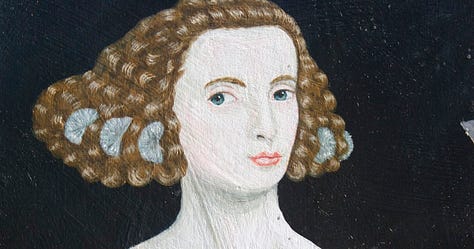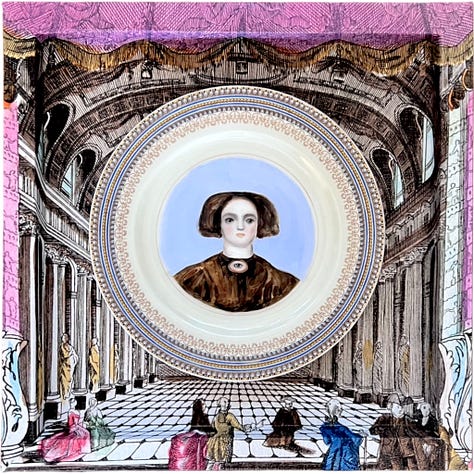
The Enduring Charm of the Spanish Infantas
The iconic nature of these portraits is no doubt in part due to the wonderfully extravagant but perfectly balanced silhouettes of mid-17th-century Spanish court fashions, which are at once richly sumptuous and substantial, and yet almost confectionery in their soft colors and sparkling metallic embellishments. We usually think of 18th-century France when we see paniers wide enough to necessitate the broadening of doorways, but here they are a century earlier. The charm of the portraits, especially those of the young princesses (although the Queen herself was herself a young woman of 18 or 19 in her portrait), comes from the contrast between their doll-like complexions and childlike frames, weighted down by both layers of lace and fabric and layers of responsibility and expectation.
The elder sister, Maria Theresa, went on to marry her double first cousin, the great Sun King, Louis XIV of France, and became the matriarch of the Bourbon Dynasty which eventually inherited the seat of Spain as well. The younger sister, Margarita, went on to marry her uncle, the Holy Roman Emperor, Leopold I, and sadly died at the age of 21 after 6 pregnancies in 6 years.
Here is Velasquez’s most famous painting, Las Meninas, with the Infanta Margarita glowing with childlike innocence and future hope from the light falling upon her. The artist himself is “in charge” of the scene, as it were, standing to the left in front of the canvas he’s painting of the Infanta’s parents, King Philip IV and Queen Mariana, who are reflected in the mirror at the back of the room, and would be standing where we, the viewers, stand. It’s an exact behind-the-scenes reversal of an official, imposing, regal “swagger” portrait of monarchs, with instead a casual collection of court attendants, dwarves, and a dog making up the retinue.
Pablo Picasso (1881-1973) was fascinated with Las Meninas and painted 45 variations of it in 1957, in part as an artistic obsession, and in part as a political statement against Spain’s continued captivity of Republicans captured during the civil war.
I don’t fully understand Picasso’s politics or abstractions, but I do understand his passion for the painting. Over the years, there have been countless interpretations by contemporary artists of the Infantas, and here are my three favorites. Rather than emphasizing the disorder and violence of Spanish history, they create magic in an alternate world with undertones of majesty and hints of tragedy around the edges.
-
Igor & Marina (Igor Kozlovsky (b. 1956) and Marina Sharapova (b. 1960), St. Petersburg, Russia).
-
Manolo Valdes (b. 1942, Valencia, Spain)
-
Anne Siems (Berlin, Germany)
I’ve been enchanted for years by the stories and destinies of the Infantas, and although I’ve painted several of the silhouettes in my usual romantic realism style and in miniature portrait plates such as these…
…I’ve also been wanting to see if I could capture some of the innocence and charm in a style that’s contemporary and more casual. The paintings are currently on a small scale - sketches, really - as I work out the ideas that will work in more monumental sizes, with a calm, muted palette, subtle but bold silhouettes, and an almost sculptural quality to them.
I’ve collected a series of vintage museum books, and about Velasquez one writes of another of his portraits that: “It is an affirmation of the artist’s conception according to which every object or being is an actor in the ‘theater of the world,’ as Calderon put it. Everyone’s identity must be preserved, in artistic form, in a choral series of ‘portraits’ that make up the infinitely animated universe.” (Prado Madrid, 1968).
For me, this style is my way of abstracting the Infantas from their historical settings and turning them into imaginary characters that we can all relate to on something like a storybook level. Although the style pares them down, it still maintains the essence of their fresh faces, their commanding poise, and the notion that we must all face our destinies head-on, even in a world that at times demands everything from us.































Leave a comment
This site is protected by hCaptcha and the hCaptcha Privacy Policy and Terms of Service apply.